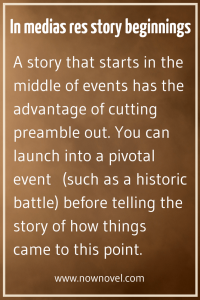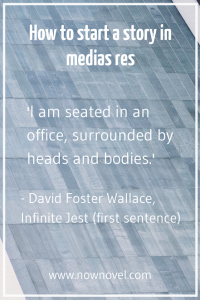The Latin term in medias res literally means 'in the midst of things' and is a literary technique that describes a story that skips exposition and starts with events already underway. Read further explanation of this term and 6 steps to make your own in medias res story opening strong:
Step 1: Choose a pivotal, emotional scene for your in medias res opening
The term in medias res was first used by the Roman lyric poet Horace who said that an epic poetry should not begin 'from the egg' but should 'snatch' the listener 'into the middle of things'. He provided this Latin term with its first use in his poem Ars Poetica. Homer does exactly this in The Iliad which begins with an argument. Novels that start this way are non-linear. The traditional fairy tale is the classic example of linear narrative, a story that does not begin in medias res. The words: 'Once upon a time' begins a story right at the start.
A story that starts in the middle of events has the advantage of cutting preamble out. You can launch into a pivotal event (such as a historic battle) before telling the story of how things came to this point.
When you start a story in medias res, take advantage of not having to begin with a slow-building chain of cause and effect. Begin with a scene that has a strong emotional core. For example, you could show:
- Your central character in a dilemma (such as a life-or-death situation or tough choice)
- Your main character doing something unusual that elicits curiosity (e.g. hurriedly digging a deep pit in the woods in the dead of night)
When you start a story in the middle of events, the reader has less of a guide to understand what's going on. Because of this, it's crucial to make your opening interesting and charged with emotion and significance. Scenes and scenarios that are beguiling in themselves make waiting for explanation exciting rather than frustrating.
Step 2: Plan how you will reveal backstory preceding your story's beginning

Because there is no exposition you will need to catch the reader up with the origins of your characters' situation another way. There are several ways to do this. You can reveal prior events through dialogue (although this can result in clumsy info-dumping - more on this further). You can also reveal backstory via flashbacks or switches in narration between past and present. Whether you choose one approach or a combination, plan how the missing pieces will slot into place.
A 'frame narrative' or story within a story is one option for using dialogue or direct speech to draw the reader in after your exposition-free opening. A central character could tell another, listening character, a story leading up to their present situation.
An example of this type of in medias res opening is Joseph Conrad's Heart of Darkness. In Conrad's novella, the narrator retells a lengthy monologue told to him and others aboard a ship by the story's protagonist, Marlow. The narrator relays Marlow's account of a disturbing voyage into the power-corrupted heartland of violent colonial exploitation in Central Africa.
There are many useful examples of novels that begin in medias res and use flashbacks to fill in the blanks. The ancient Greek text The Odyssey (attributed to Homer) is the famous example.
The story begins with Odysseus' son Telemachus attempting to find news of his missing father while his mother Penelope holds suitors (convinced of Odysseus' death) at bay. We proceed to read of Odysseus' travels and trials via flashbacks.
More modern examples of novels that open in the middle and reveal the backstory for their opening paragraphs through flashbacks include Neil Gaiman's Nebula- and Bram Stoker- winning American Gods (2001) and Yann Martel's Life of Pi (2001).
Medias res examples from film include Saving Private Ryan, which starts in the middle of an invasion on Omaha Beach during World War II. Typically the James Bond films also begin this way, sometimes with an action scene. Then there's Forrest Gump, with that famous line, 'Momma always said life is like a box of chocolates — you never know what you're gonna get.' As the film opens Gump is on a bench telling his story, revealed through flashbacks. The device is also very popular in film noir.
Step 3: Make the opening event or action crucial to your plot
This is crucial advice for any opening. Too little relevance to your core story and your opening will likely feel 'tacked on' and insignificant. When you begin in medias res, make sure that the action or event you throw the reader into is pivotal to your plot as a whole.
In The Odyssey, the opening launches into the chain of events key plot points (Odysseus' journey back home and his wife's dilemma back home) immediately.
When you begin in the middle of things, choose a point in your plot that raises the stakes like The Odyssey's opening does. Because of the urgency of Odysseus' return due to the unfolding events back home, we invest quickly in the outcome of the character's story arc.
Step 4: Make readers want to know how events built to this point
A story that starts in medias res should pique the reader's curiosity. The intrigue created by delayed exposition is why in medias res is a popular type of story opening with mystery authors. It allows questions to pile up.
To get the reader interested in not only what is going on now but why events are unfolding a certain way, craft your opening so that the reader asks questions. Questions such as 'Who?', 'Where?' and 'When?'
If, for example, you open your novel with a character mid- phone call, making urgent arrangements to meet a mysterious other at a specific place and time, the reader will have multiple questions. Who is the person on the end of the line? Why is their meeting so urgent? What is the significance of their meeting place? What situation has made their meeting so important?
Propelling your story forwards this way gives readers narrative events to look forward to so that explanatory exposition is replaced by the suggestion that there will be clarification further on. It also means that your reader is immediately curious, and so invested in the story. They are probably already thinking about it and trying to fill in the blanks.
You can also create dramatic irony in your writing by showing the reader a future event -- such as a character dying -- and then returning to the chronological start. The character won't know that they will die in a year's time but the reader will. This will be immediately create a mood or mindset in a reader. Examples of this can be found in the film American Beauty which opens with foreknowledge of Lester Burnham's death.
Step 5: Check that you aren't info-dumping
A danger of opening a story in medias res is that you might be tempted to use big lumps of clunky exposition ('info-dumping') to catch the reader up.
To avoid info-dumping, make sure characters don't discuss events solely for the reader's benefit. This type of info-dumping is clumsy. We're aware as readers that the author is making her characters repeat what both already know, solely for our benefit.
For example:
'As you remember, Tom, we had to get to the rendezvous spot - that abandoned lot on the Upper East Side - at 10:00 p.m. because Jake's guys were delivering the explosives.'
'Yeah, I know. You'll remember we missed the appointment because we were stuck behind that damn burning tanker on the freeway.'
If your characters are reminding each other of events they both participated in, you're likely mid-info-dump. Read this guide to avoiding info-dumps for ways to craft less obvious exposition.
Step 6: Write an intriguing first line

When you start a story in the middle of action, it's especially important to write a strong first line. In the absence of exposition, the introduction to your primary character(s) and your opening setting should be strong. Engrossing enough to carry the reader along until you fill in more blank spaces.
Take the opening line of Gaiman's American Gods, for example:
Shadow had done three years in prison.
Without any exposition, we're told about a significant part of the main character's past in the opening line. Naturally, we want to know why Shadow served time.
Another good example of an in medias res opening is David Foster Wallace's Infinite Jest (1996):
I am seated in an office, surrounded by heads and bodies.
Dismembered heads and bodies? Or are the parts still attached to their owners and the narrator is speaking metaphorically? Foster Wallace uses ambiguity to create intrigue and draw us in.
What's your favourite in medias res story opening? Share in the comments. Then join Now Novel and get insightful feedback on your work-in-progress' opening line and more.










Another great post. I do love being dropped straight into the action. It goes against what newbie writers are taught in terms of story arc - that there is always a moment before the action begins - a moment of stasis. Great tips for making it work...
Joanne Burn - Almost 9 years ago
Thank you, Joanne. You're right that newbie writers are taught all sorts of things but ultimately it definitely is best to adapt the rules to your story (rather than the other way around).
Bridget At Now Novel - Almost 9 years ago
Wonderful post! It arrived also at the right time - I am starting "in medias res" the second draft of my novel, after realising that I had gone the long, drawn out build up route and was running into a monster of a book. This is just what I needed to confirm I'm doing the right thing. Thanks
Gabyprado - Almost 9 years ago
Thank you, Gaby, I'm glad to hear that. It's a pleasure! All the best for reworking your beginning.
Bridget At Now Novel - Almost 9 years ago
Really great post. These are things you may know intuitively, but it solidifies your thinking when you read it and go, "Uh huh, that's it."
Rob Hoey - Almost 9 years ago
Thanks so much, Rob.
Bridget At Now Novel - Almost 9 years ago
Algorithms! I've puzzled,pulled my hair and making myself mad with this. Not only does starting in the middle have a name! But suddenly a solution presented itself reading this post. Thanks ?? - The algorithm: this post came up on my Facebook feed today. The universe gently pushing me back to my desk?
Anne Campbell Weimoth - Over 8 years ago
Hi Anne - I'm really glad to read that you found this helpful. Hope the universe and Facebook keep conspiring to do this.
Bridget At Now Novel - Over 8 years ago
This is what I was looking for! I am currently writing a novel where it begins in the middle, and alternating chapters tell the beginning to build up to the big finish where it all ties together. I was looking for confirmation that it would not go into the realm of too confusing. It definitely helped me make my final decision.
Ariana - Over 7 years ago
Howard Roark laughed.
Demokan - About 3 years ago
Good example from The Fountainhead, Demokan.
Jordan - About 3 years ago